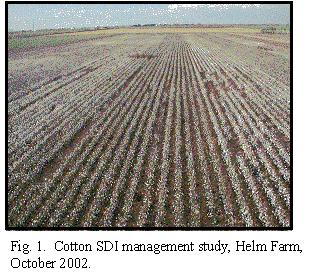James P. Bordovsky, Joe Mustian, and Megha Parajulee
Objective: The objective was to evaluate cotton production under two management scenarios: 1) High Input which focuses available resources on small areas to achieve maximum yields and 2) Normal Input which distributes resources over a wider area to achieve sustainable yields.
 Methodology: Cotton was planted in a field where a ten-zone SDI system was installed. Irrigations were applied in alternate furrows of 30-inch rows with each zone 1300 ft by 16 rows wide and independently controlled and metered. Two cotton management strategies were compared. A High Input, high-yield management scenario with the production goal of 3.5 bales per acre and no restriction on input level was replicated in four plots. The Fibermax 989BGRR variety received 15.7 inches of seasonal irrigation, 66 lbs. N/ac in eight seasonal drip irrigations, 7 oz. Pix/ac in two directed spray applications, and a higher than normal level of insect pests control. The Normal Input scenario, with an annual yield goal of 2.5 bales per acre, was also replicated four times. Paymaster 2326RR cotton variety was seasonally irrigated with 11.6 inches of water, 37 lbs of N/ac was injected in three irrigations, and insects controlled at normal thresholds. Two additional plots were treated as dryland production.
Methodology: Cotton was planted in a field where a ten-zone SDI system was installed. Irrigations were applied in alternate furrows of 30-inch rows with each zone 1300 ft by 16 rows wide and independently controlled and metered. Two cotton management strategies were compared. A High Input, high-yield management scenario with the production goal of 3.5 bales per acre and no restriction on input level was replicated in four plots. The Fibermax 989BGRR variety received 15.7 inches of seasonal irrigation, 66 lbs. N/ac in eight seasonal drip irrigations, 7 oz. Pix/ac in two directed spray applications, and a higher than normal level of insect pests control. The Normal Input scenario, with an annual yield goal of 2.5 bales per acre, was also replicated four times. Paymaster 2326RR cotton variety was seasonally irrigated with 11.6 inches of water, 37 lbs of N/ac was injected in three irrigations, and insects controlled at normal thresholds. Two additional plots were treated as dryland production.
Results: The High Input treatment produced significantly higher lint yield, loan values, and seasonal irrigation water use efficiencies than the Normal Input treatment (Table 1). The lint yields were increased by over 400 lb/ac, loan values increase by ~ $0.04/lb of lint, and WUE increased by 10.6 lb lint/ac-in in High verses Normal Input treatments. Based on this year’s data, installing only a portion of a field in SDI and providing full resources to achieve maximum yield in that area not only reduces initial SDI costs, but, also, increases gross returns per total area compared to installing SDI and stretching limited resources over the entire area. Production over multiple years is needed for valid economic comparisons.
Table 1. Comparison of cotton lint yield, loan values, and water us efficiency from Normal and High Input treatments irrigated by SDI.
*Means followed by the same letter in the same row are not significantly different (P<0.05, Duncan)
| Normal Input | High Input | Difference | |
| Yield (lb lint/ac) | |||
| Hand Harvest | 1055 b | 1566 a | 511 |
| Machine Harvest | 1019 b | 1433 a | 414 |
| Loan Values ($/ac) | |||
| 0.443 b | 0.482 a | 0.039 | |
| Gross Value @ Loan ($/ac) | |||
| 451 | 691 | 240 | |
| Seasonal Irr. WUE (lb lint/ac-in) | |||
| 60.8 b | 71.4 a | 10.6 |

